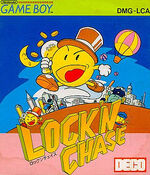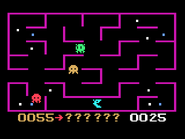This page details games which "clone" the general gameplay premise of Pac-Man.
As Pac-Man was effectively a genre-defining game, works utilizing the concept of Pac-Man were soon to follow. These games can range from being complete copies of Pac-Man, to being unique works that only slightly derive from the Pac-Man formula. Additionally, these titles - at least to some extent - attempt to redesign the Pac-Man characters visually.
What generally defines a Pac-Man clone is a game where the player collects dots in a labyrinth, while avoiding enemies or other obstacles. Equivalents to the Power Pellet - allowing the player to "turn the tables" on the enemies - are also common in such games. The term generally applies to originally-coded titles; while hacked and bootlegged versions of Pac-Man are often categorized as separate entities.
K.C. Munchkin!

European Munchkin box art
K.C. Munchkin!, known as just Munchkin in European territories, is a game released for the Magnavox Odyssey² system in 1981.
Phillips (and Magnavox) initially wanted to obtain the Pac-Man license from Namco to release an Odyssey² port of the game. However, Namco had just granted Atari the exclusive Pac-Man home console rights; leading to a deal being impossible. As such, Phillips attempted to create an unlicensed clone of Pac-Man, with just enough adjustments to make the game legally distinct. At this point in time, however, what could be considered copyright infringement in regards to video games was still unclear.
The initial change decided for the game was to an actual gameplay mechanic. There are only twelve dots in each stage; however, the dots move around the maze, as opposed to being stationary. In some levels, the maze's walls can randomly change position as well. By this point, however, the game still literally featured Pac-Man and the Ghosts as characters;[1] later in development, Pac-Man was turned blue and given antlers (the titular "K.C."), and the Ghosts' bottom halves were slightly altered. With these alterations made, the game was finished and officially released for the console.
Despite the attempts to make K.C. Munchkin unique from Pac-Man, Phillips would be subject to a lawsuit with Atari regarding the game ("Atari, Inc. v. North American Philips Consumer Electronics Corp.", 672 F.2d 607). Initially, Atari was denied a preliminary injunction against Phillips; though after Atari filed an appeal, this decision was reversed. The judge found that, while copying of Pac-Man's gameplay formula was not illegal, K.C. Munchkin's character design was clearly copied from Pac-Man and the Ghosts. The case was ruled in favor of Atari, with K.C. Munchkin being pulled from production immediately afterward.
The Atari v. Phillips lawsuit is considered to be a landmark case regarding the copyright of video games. While the "legally gray" line for derivative games was previously unclear, this case was the first to properly define the criteria.
K.C.'s Krazy Chase!
K.C.'s Krazy Chase! is the sequel to K.C. Munchkin, released on the Magnavox Odyssey² in early 1982.
Krazy Chase was developed amidst the Atari v. Phillips lawsuit - and the game is effectively a jab at Atari themselves. The player guides K.C. through a maze with growing "trees", eating a giant "Dratapillar" from behind. This is a clear parody of Atari's Centipede; with the Dratapillar and trees being the centipede in the mushroom patch. The game was never subject to any legal action, likely as it would potentially fall under parody law.
Arcade games
Lock 'N' Chase

Japanese Lock 'N' Chase Game Boy box art

Lock 'N' Chase gameplay
Lock 'N' Chase (ロック・ン・チェイス Rokku 'N' Cheisu) is a game produced by Data East in 1981. The game is a cops-and-robbers-themed take on Pac-Man.
The player controls a thief, and must collect (or rob) all of the coins in a bank vault. The thief then must exit the vault without running into the police officers, who are effectively just the Ghosts in police uniforms. Additionally, the thief can set "trap walls" to block the police from reaching him. The game does not feature an equivalent to the Power Pellets.
This game was produced in two different arcade forms: being released as part of Data East's DECO Cassette system, and as a standalone machine (released by Taito in the U.S.). In earlier versions of the game (including the Japanese DECO release), Lock 'N' Chase had even more visual similarities to Pac-Man; such as the policemen's starting points being placed inside a mini-pen (instead of the maze tunnels), "coffee break" intermissions, and much closer sound design.
Lock 'N' Chase received several home console ports: including on the Atari 2600, Intellivision, Apple II, and a few more modern platforms. The most notable home console port is the Game Boy version, which acts as a full remake of the game; adding new levels and power-ups, with a large visual overhaul.
The Hand
The Hand was released in Japan in 1981 by T.I.C.; in North America, it was released by Game-A-Tron as Got-Ya.
The Hand, while still cloning Pac-Man's gameplay, is based on the rules of Rock-Paper-Scissors. The player and enemies are hands; if the player's hand position beats the enemy, they will defeat the opposing hand (and vice-versa). If both hands are the same, the player character will tip his hat and declare it a tie. Collecting a dollar sign will allow the player to change their hand position. The game makes use of voice samples during gameplay.
Upon completing a level, the player character turns into something resembling Popeye's head; when transitioning to the next maze, Olive Oyl appears and congratulates "Hopeye". In later revisions of the game, Olive Oyl is replaced with a generic woman, and refers to the player as "Handy" (though the voiceover still says Hopeye).
Curiously, the game's graphic data seems to be copied and traced from the original Pac-Man. This may suggest the game is an advanced hack of Pac-Man rather than a true clone, though this cannot be confirmed.
Other platforms
Jawbreaker
Jawbreaker is a game originally written by John Harris in 1981. The game was first released for Atari 8-bit computers (Atari 400/800/XL/XE), published by On-Line Systems, and was later "ported" to the Apple II. An entirely unique version of the game (sometimes referred to as "Jawbreaker II") was later released for the Atari 2600, among other platforms.
Initially, John Harris had developed an Atari 8-bit port of Gobbler, a direct copy of Pac-Man released by On-Line; amidst this, however, Atari had halted production of Gobbler. Ken Williams (the head of On-Line Systems) had researched the then-recent Atari v. Phillips lawsuit, and believed the game could still be released if all of the characters were altered. Harris was asked to make the game legally distinct; he attempted to do this by giving the Ghosts mustaches and sunglasses, and nothing more. After being told this would clearly not work, he begrudgingly retooled the game to have a "candy" theme, being renamed "Jawbreaker"; with Gobbler being re-released under this theme as well.[2]
Through unclear means, Atari obtained the "sunglasses" copy of the Gobbler prototype; finding the port to be of high quality, they attempted to flat-out purchase the rights to the prototype. At this point, the game had already been reworked into Jawbreaker; this led to Harris declining the Atari deal, with Jawbreaker being released by On-Line instead.[2]
Atari would then file suit against On-Line Systems. This case was somewhat strange, as Atari could not cite infringement based on the Pac-Man characters; instead, they cited the direct copying of the maze layout (which was merely turned 90 degrees on its side). On-Line attempted to argue that Pac-Man itself was derivative of Sega's Head-On; with Harris even reprogramming Jawbreaker for court demonstration, showing it with a Head-On-copying maze instead of the Pac-Man one. Somehow, Harris accidentally overwrote the master production file for Jawbreaker in this process, resulting in future retail copies using the Head-On maze.[2]

Taiwan Cooper "Tooth Brush" cartridge
Ultimately, this case was settled out of court; though following the lawsuit, Jawbreaker was still sold on the market. An Atari 2600 port of the game was later produced; while still somewhat derivative of Pac-Man, the 2600 release was largely original conceptually. The 2600 version of the game (with its unique factors) would later be re-ported to the Atari 8-bit platforms, now marketed as a "sequel". Some "Taiwan Cooper" 2600 releases of the game (renamed to "Tooth Brush") use what is clearly Atari's incarnation of Pac-Man on the cover.
Devil World

European Devil World NES box art
Devil World (デビルワールド) is an NES/Famicom game, developed and released by Nintendo in 1984. The game has never been released in North America, due to its heavy religious themes, but did see release in Japan and Europe. The game's first stage is a clone of Pac-Man.
The player controls the green dragon Tamagon, and navigates him through a series of mazes to "attack the Devil's world". Touching crosses powers Tamagon up, allowing him to breathe fire and eat the dots in the maze. The Devil dances at the top of the screen, pointing the direction for his minions to move the maze; this can be dangerous, as Tamagon can be squished if caught between a maze wall and the moving outer boundary.
After the first maze is cleared, the next objective is to put four Bibles into a seal; the Bibles also give Tamagon fire-breathing abilities. After carrying them all into the seal, the Devil turns into a tiny bat, and flies to the next maze.
Pac-Man technically has a crossover appearance with Devil World. In Super Smash Bros. for Nintendo 3DS / Wii U and Super Smash Bros. Ultimate, the Devil appears as an Assist Trophy; while Pac-Man is a playable character in all three games.


